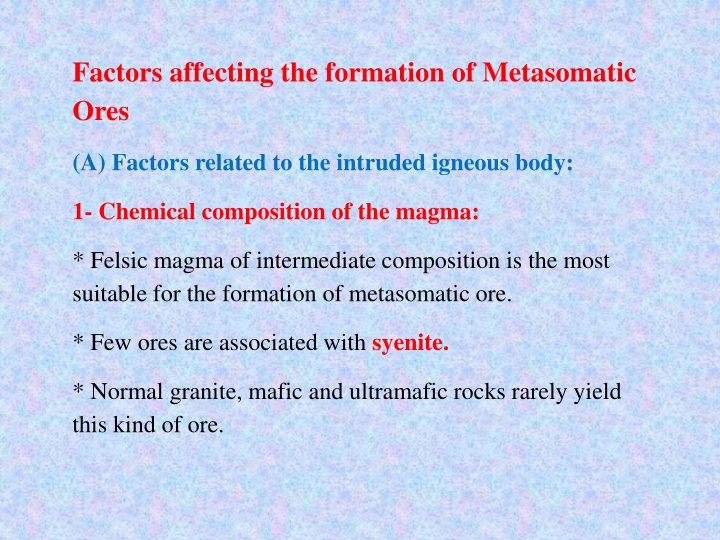
Formation of Metasomatic Ores: Factors and Properties
Explore factors influencing metasomatic ore formation related to intrusive igneous bodies and surrounding rocks. Learn about ore properties such as mineral composition and deposit characteristics.
Download Presentation

Please find below an Image/Link to download the presentation.
The content on the website is provided AS IS for your information and personal use only. It may not be sold, licensed, or shared on other websites without obtaining consent from the author. If you encounter any issues during the download, it is possible that the publisher has removed the file from their server.
You are allowed to download the files provided on this website for personal or commercial use, subject to the condition that they are used lawfully. All files are the property of their respective owners.
The content on the website is provided AS IS for your information and personal use only. It may not be sold, licensed, or shared on other websites without obtaining consent from the author.
E N D
Presentation Transcript
Factors affecting the formation of Metasomatic Ores (A) Factors related to the intruded igneous body: 1- Chemical composition of the magma: * Felsic magma of intermediate composition is the most suitable for the formation of metasomatic ore. * Few ores are associated with syenite. * Normal granite, mafic and ultramafic rocks rarely yield this kind of ore.
2- Size and form of igneous body: * Stocks and batholiths usually associated with metasomatic ore * Laccoliths and large sills rarely contain this ore * Dikes and small sills never contain such ore
3- Depth of intrusion * characterized by coarse texture indicating slow cooling at depth. Metasomatic ores are associated with rocks * Metasomatic ores not found in rocks with glassy texture indicating rapid cooling near the surface. * The most suitable depth in the formation of this kind of ores is 1000-2100m.
(B) Factors related to the surrounding rocks: 1- Chemical composition: * These ores occur in association with the chemically high reactive rocks such as the sedimentary carbonate rocks. * Less common in sandstones. * Seldom in igneous and metamorphic rocks. 2- Structure of the surrounding rocks: * Rocks with faults, joints, fractures are more suitable for metasomatic ores. * Gently dipping sedimentary rocks are more suitable than horizontal sedimentary beds.
Properties of metasomatic ores: 1- The ore minerals consist of oxides, native metals, sulfides, and sulfosalts. 2- The gangue minerals are high temperature minerals such as; tremolite, actinolite, garnet. 3- The deposits consist of several disconnected ore-bodies. 4- Metasomatic ore deposits are small in size (30-120m3). 5-The deposits are scattered irregularly around the contact close to be the igneous body. 6- The ore minerals are coarse in texture containing large crystals or clusters of crystals.
